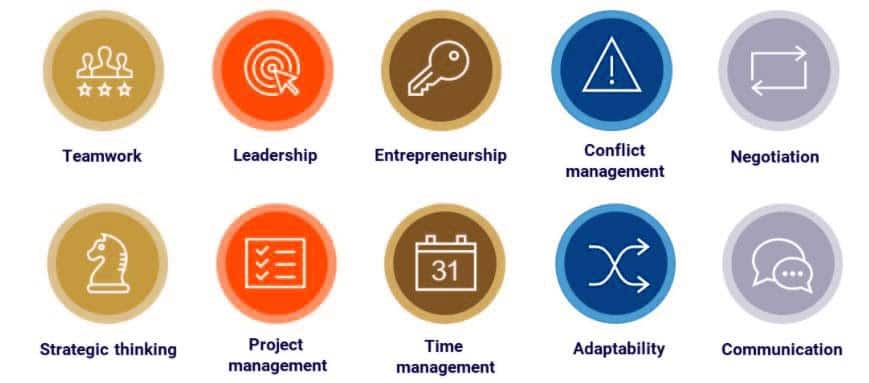Great Lakes - PGDM & PGPM Admissions 2026
Application deadline: 4th Dec | Globally Recognized by AACSB (US) & AMBA (UK) | 17.8 LPA Avg. CTC for PGPM 2025
Skills for a Management Career: From the workplace to course activities, there are some skills that are not only useful in life but also highly desired by employers. In this article, we would like to introduce you to the top 10 management skills you need to enhance your career and personal growth. You do not need management skills? Think again. Contrary to popular belief, management skills are beyond organizations and companies; they help improve your professional path, your personal skills, and your relationships. If you want to advance in a management role, you need the best set of skills. If you were invited for an interview, use your past experience to illustrate how you acquired and developed the following skills just like yourself.
Candidates who appeared for the Computer-based IIM CAT 2025 on November 30 and awaiting the answer key and response sheet to calculate their probable scores can check the score vs percentile for each slot 1 by experts from the table given below.
Percentile | CAT 2025 Slot 1 (Prediction) | CAT 2025 Slot 2 (Prediction) | CAT 2025 Slot 3 (Prediction) |
99.95 | 115+ | 110+ | 112+ |
99.9 | 103–106 | 101–105 | 102–104 |
99.5 | 90–92 | 89–91 | 88–90 |
99 | 78–80 | 77–79 | 76–78 |
97 | 66–68 | 65–67 | 65–67 |
95 | 56–58 | 55–57 | 55–57 |
90 | 45–48 | 44–46 | 44–45 |
85 | 40–42 | 39–41 | 39–40 |
80 | 35–36 | 34–35 | 34–35 |
75 | 32–33 | 31–32 | 31–32 |
70 | 30–31 | 29–30 | 29–30 |
60 | 25–26 | 24–25 | 24–25 |

Traditionally, the term “Management” refers to four common functions (and often a group of people) involved: planning, organizing, leading, and coordinating resources. Note that the four functions are repeated throughout the system and are highly integrated. This topic helps the reader to gain a comprehensive understanding of the areas of knowledge and skills required to perform the key functions of management.
According to (Management Innovation, 2008), "Management is the process of achieving organizational goals by working with people and other organizational resources."
It is a process or series of continuing and related activities.
It involves and concentrates on reaching organizational goals.
It reaches these goals by working with and through people and other organizational resources.
In addition, management combines all six Ms., namely men and women, money, methods, machinery, materials, and markets. They use these resources to achieve the goals of the organization, such as high sales, maximum profit, and business expansion.
Also Read: BBA or Integrated MBA - Which Course to Choose after Class 12?
Management skills are highly transformative, profitable, and beneficial. They can be useful beyond employer-employee relationships.
Entrepreneurship
Teamwork
Leadership
Strategic thinking
Project management
Conflict management
Negotiation
Communication
Time management
Adaptability

Check out below the top 10 managerial skills that every MBA aspirant needs.
The ability to work in a team provides new and different perspectives, helps with motivation, and reduces stress. Ultimately, a team is a great learning opportunity and may open doors that you may not even know exist. In the work world, teams are increasingly trusted as a tool to increase organizational efficiency and effectiveness.
Wondering how to improve your teamwork skills? Be comfortable with highly effective team management ideas such as team performance and team mentality models. Both concepts have a strong track record when it comes to improving team performance and can be easily used in everyday business.
Investing in leadership is about investing in your ability to help express the best from yourself and others. Good leaders can act not only as forerunners of ideas but also as persuasive motivating guides to help others go beyond their expectations. How to become a leader? There are plenty of different leadership approaches. Consider transforming leadership as a starting point.
Entrepreneurial skills are tools that help make a vision a reality. Consider startups and their founders: Often, entrepreneurs are practical and confident, beautiful communicators who are not afraid to think outside the box and put something new in the world. As the late Steve Jobs famously said: "stay hungry, stay foolish".
It’s natural that people disagree on all sorts of systems—they will. Disagreement is normal and healthy, but only when properly managed. Learning some expansion strategies and taking the time to understand different perspectives can go a long way regardless of your position.
An old adage goes that “nothing in life comes for free”, which means we have to work for the things we want to achieve. A talent that is useful not only in politics but in all spheres of life—a big part, being able to say what you want in a harmonious, respectful way. Negotiation skills will last as long as asking to find a compromise in a fair and professional way.
You do not need a complete fleshy strategy to be strategic - on the contrary, strategic thinking is a continuous process of "strategy". Think about chess: When playing, you can plan ahead, be brave, be intentional, and constantly improve your tactics depending on what you learn. To win the game, you need to prioritize, consider some possible scenarios and make decisions based on the best resources available.
Any endeavor that is limited at any time and has a specific goal can be considered a project (learning new skills, getting promoted, building a house, etc.). Project management skills help you define, plan, organize, guide and control. With a plan away from confusion, you can achieve things like being strategic with your resources and learning from failure while monitoring progress.
Time management is not just about being on time (it’s a great skill that leaves a lasting good idea!). Learning to use your time more without procrastination (surprisingly) gives you more time, avoids frustration, and can be accomplished. Bonus: You can re-invest your time in things you really care about.
No one knows everything, and being aware of it is often helpful, especially in a fast-changing world. If you want to take a new path and try something completely different without abandoning your principles, you will always be in a state of renewal and will never stop learning. This is a good starting point for innovation.
Effective communication skills can be considered basic life skills. It is not possible to perfect the ability to communicate information, but working on it can help personal relationships, improve your confidence, and really elevate your life.
There are many different ways to improve your management skills. One of the easiest ways is self-examination. You can read business books and intellectual articles about your most important management skills.
On Question asked by student community
If you filled the UGC NET form under EWS but you don’t have a valid EWS certificate, then forget using the EWS category. They won’t accept it. You’ll automatically be treated as General category during document verification.
And no, this won’t make your form “invalid” or “illegal.” It just means you won’t get the EWS benefit.
So yes — you can still go for General category posts and Professor recruitment. Just don’t try to submit a fake/invalid certificate; that will get you disqualified.
Hello,
If your CAT admit card shows your surname first followed by your first name as entered in the form, it is correct. You do not need to worry about this format as long as it matches the details you provided. Ensure all other information on the admit card is accurate and carry it to the exam along with the required identification documents.
Hope this helps you.
Hello,
If your CAT admit card has a different date of birth than your Aadhaar card, you should get it corrected immediately . Here’s what you can do:
Check the CAT website : Log in to your candidate portal and look for the option to correct personal details.
Contact the CAT helpdesk : Email or call them explaining the issue. Attach a copy of your Aadhaar card as proof.
Do not ignore it : The date of birth must match your ID, otherwise you may face problems at the exam or during admission.
Usually, the CAT authorities allow corrections before the exam, so act quickly.
Hope it helps !
Hello,
Here are Documents Required for CUSAT CAT (NRI Quota):
To know more access below mentioned link:
https://engineering.careers360.com/articles/cusat-cat-application-form
Hope it helps.
To get admission into the MBA program course 2026 to 2028 at Great lakes institute of management Gurgaon you need to check about the specific eligibility criterias and the admission process
follow the link given below by careers 360 to get the detail admission process overview into the MBA program at Great lakes institutes of management Gurgaon
https://www.careers360.com/colleges/great-lakes-institute-of-management-gurgaon
Application deadline: 4th Dec | Globally Recognized by AACSB (US) & AMBA (UK) | 17.8 LPA Avg. CTC for PGPM 2025
IBSAT 2025-Your gateway to MBA/PGPM @ IBS Hyderabad and 8 other IBS campuses | Scholarships worth 10 CR
Ranked #36 amongst institutions in Management by NIRF | 100% Placement
UGC Approved Programs | Near 100% Placement Record | Up to 100% Scholarships | Highest CTC 21.32 LPA
75+ years of legacy | #1 Entrance Exam | Score accepted by 250+ BSchools | Last Date to Apply: 5th Dec'25
Top Recruiters-Amazon, Microsoft, ITC, Marico, Mindtree & many more | Merit Scholarships available